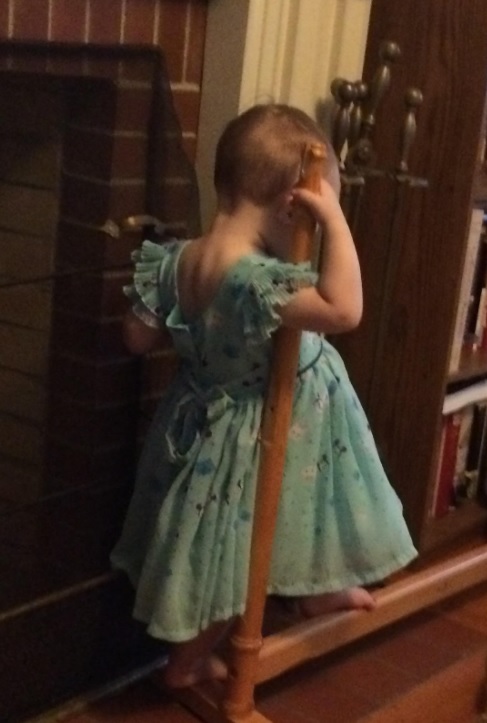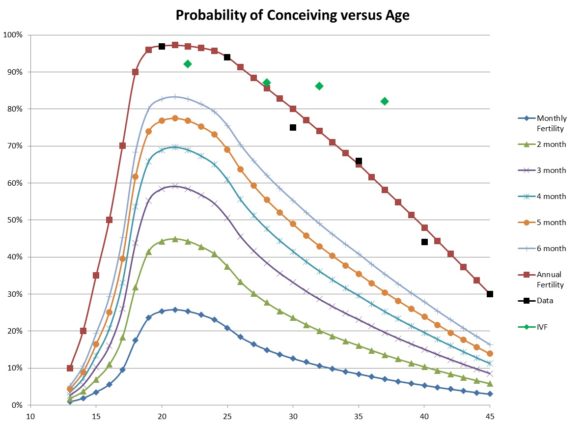
Recently I wanted to find out the probability that an average woman would get pregnant at any given age.
I was really surprised by what I found. In my family going back in time, people tended to get pregnant whenever it occurred to them to try. So I had this model in my head that likelihood of getting pregnant after puberty (menarche) was close to certainty in any given month when an attempt would be made, until the time when one’s body stopped wanting to deal with pregnancy.
But it turns out that the first several years of being a woman we females aren’t particularly fertile. It’s possible to get pregnant, as all too many teens can attest. But for most in that early period of time, there’s not reliable ovulation to accompany the outward signs associated with monthly ovulation. This anovulation seriously messes with likelihood of getting pregnant in the early teen years, which is awesome, since risk of maternal death is significantly elevated for folks who get pregnant before age 16.
The peak timeframe for fertility is in the early twenties. Across multiple studies, it appears a person who wishes to become pregnant at this stage of their life has a 97% chance of achieving their goal, with a 25% monthly probability of getting pregnant.
By age 25 things start to get slightly less probable, with monthly probability falling below 20%. But annual probability is still well above 90%.
As age increases, different factors come into play. The supply of eggs gets lower, and the likelihood an egg is slightly damaged goes up. This may account for the increased rate of miscarriage reported above age 30. And as age creeps up further, the probability of having a child with a disability caused by older maternal age goes from 1:500 to 1:60 – suggesting the vast majority of children will be just fine. Still, most studies indicate a person trying to get pregnant starting at age 40 has about a 50% likelihood of eventually conceiving. Pretty high, all things considered.
Use of IVF can bolster the likelihood of becoming pregnant significantly, though there are costs, both monetary and biological. I imagine folks seeking IVF in their early years are less fertile than average since the reason one would seek IVF at such an early age is because there’s some kind of problem.
For me, looking at this graph, I’m super glad the Church lowered the missionary age for women to 19. Previously if one wished to serve a mission, you were necessarily taking out your most fecund years, particularly when you accounted for the time required to find a person with whom to be fecund. Besides, missions starting at age 21 cut up formal schooling in a particularly disruptive manner. Now one can mission, get home, get some schooling, graduate, and still not have squandered too much of one’s reproductive possibilities.
And yes, I value reproductive possibilities because kids are cute and grandkids (for which kids are a prerequisite) are possibly even cuter.
The math here assumes that every woman has only a 97% likelihood of becoming pregnant in her early twenties, where there are some who are nearly certain to become pregnant in any month they attempt to conceive (me and certain ancestors and relatives) while others just aren’t going to conceive without a near miracle. But actual experiences will vary from the probability model. And these numbers assume one actually is in a position to try for children.
So, did this graph surprise you? What insights does this information give you?



Do you know why women should stop having children at 29?
.
.
.
.
.
.
.
.
.
Because 30 is just too many.
I have no insights other than last year I had a baby at the age of 43. It has been a very different experience over all, from conception, to the pregnancy itself, to the post-partum period. I would encourage couples to not put off having their children … it gets harder as your body ages.
I knew a woman on my mission in Italy who was pregnant with child number 20 or so. Several of the children had died, so they only had 8 or so at home, but even so were struggling and the father wouldn’t pay tithing and so policy prevented the Church from stepping in. Given the economic situation, we were not as sad as we might have been when we learned the pregnancy had miscarried.
Looking this up, “The greatest officially recorded number of children born to one mother is 69, to the wife of Feodor Vassilyev (b. 1707–c.1782), a peasant from Shuya, Russia. In 27 confinements she gave birth to 16 pairs of twins, seven sets of triplets and four sets of quadruplets.”
So you see, it is 70 that is too many. But I guess that wouldn’t work as a joke.
Women like to say that if men had the babies, each family would have no more than one child. But I say that if men had the babies, there would be open bragging about unanesthetized births, particularly in primitive conditions or with freakishly large stats (weight, length, number).
One sees the bragging among women, but it’s relatively genteel, speaking of the situations with subdued voices and sympathetic shudders.
It is relatively common for women to continue to be able to conceive into their 40s, hence the families in Mormon and Catholic circles you may have known with 10 or more children (where there weren’t multiples born from a single confinement).
It’s potentially useful to consider my 2015 post about the ideal number of children:
Ideal Family Size? Do Two Kids Make Sense
The summary is: Intelligent married couples should be planning to bear at least 4 children.
Something to consider regarding those 40-year-old Mormon or Catholic mothers: If such a woman bore eight children already and nursed them, she has perhaps twelve fewer years of ovulation behind her than she would if she had never conceived. I don’t know if that enhances her fertility at 40.
From what I recall, a woman who bears children has a reduced likelihood of dying from certain factors, so there’s definitely something going on.
The studies summarized at the wikipedia article on Age and female fertility are relatively consistent for younger women but vary widely when they get to older women. I note that the website that talks about IVF put forward a graphic that suggests female fertility is much lower than seen in these other studies, which suggests they are attempting to present the idea that IVF is almost required to ensure conception.
I will say that the shape of the curve helped me understand why an unmarried woman in her late twenties would be considered so much less desirable (e.g., a spinster). FWIW, spinster means someone who spins for a living. As unmarried women would typically be involved in the textile arts and men were often the weavers, spinning was the most highly skilled of those arts. More women would be involved in washing fiber and preparing it for spinning, but being the one to spin the fiber, that was a valuable role in society and a title to be coveted.
I just did a web search on fertility rate (as opposed to birth rate).
In the US, it is now down to 1.9, or even as low as 1.8something.
40% of US babies are now born out of wedlock.
Demography is destiny.
—
When/as the baby boomers retire, there will not be enough experienced people to take all the management/leadership and high level tech positions. There are just not enough warm bodies “in the pipeline” to replace all the people currently retiring, and set to retire in the next 6 to 7 years.
Unqualified mid level people will be promoted, leading to incompetent management, and shortages of employees at the mid levels. The Peter Principle will abound.
Someone in the know about corporate recruting told me companies are already using big pay raises to bribe baby boomers to delay retirement.
We may end up importing a lot of managment from India and China. Both/each of those countries have a middle class that alone is greater than our whole population.
Well, maybe not China. Their use of the one child policy for more than a generation will cause a cliff like drop off as that first generation of parents-of-one-child die off, since that child generation is so much smaller than their parents generation. Not exactly one half, since there were lots of exceptions in rural area.
Then the children-with-no-siblings generations have also had fewer children, because they killed many of the girl babies, or hid them and shipped them overseas, leaving too few women for the men. So those generations can’t fully replace themselves either.
So China is also set for a precipitous decline.
India is set to burst, as their nationwide population density is already over 1,000 people per square mile. That density has risen dramatically in the last 5 years.
The US has a national density of 90/sq mile.
This was the impetus behind my 2014 post encouraging married, intelligent women to consider having four or more children.
If white folks want to continue having a “white” future, then they need to populate that future. Otherwise the future belongs to those in the society who do reproduce responsibly and/or who immigrate responsibly. Since I am not fully white, I don’t mind if American shifts in the future – the phenomenon US and World Report called “the browning of America” several decades ago.